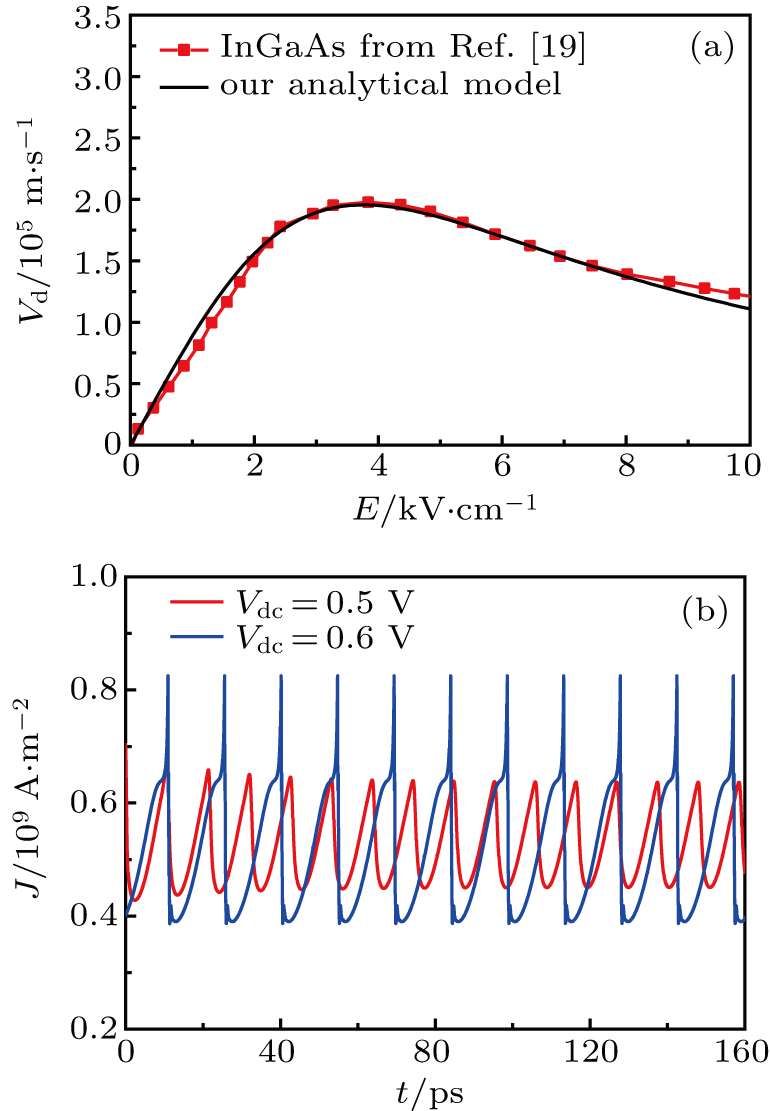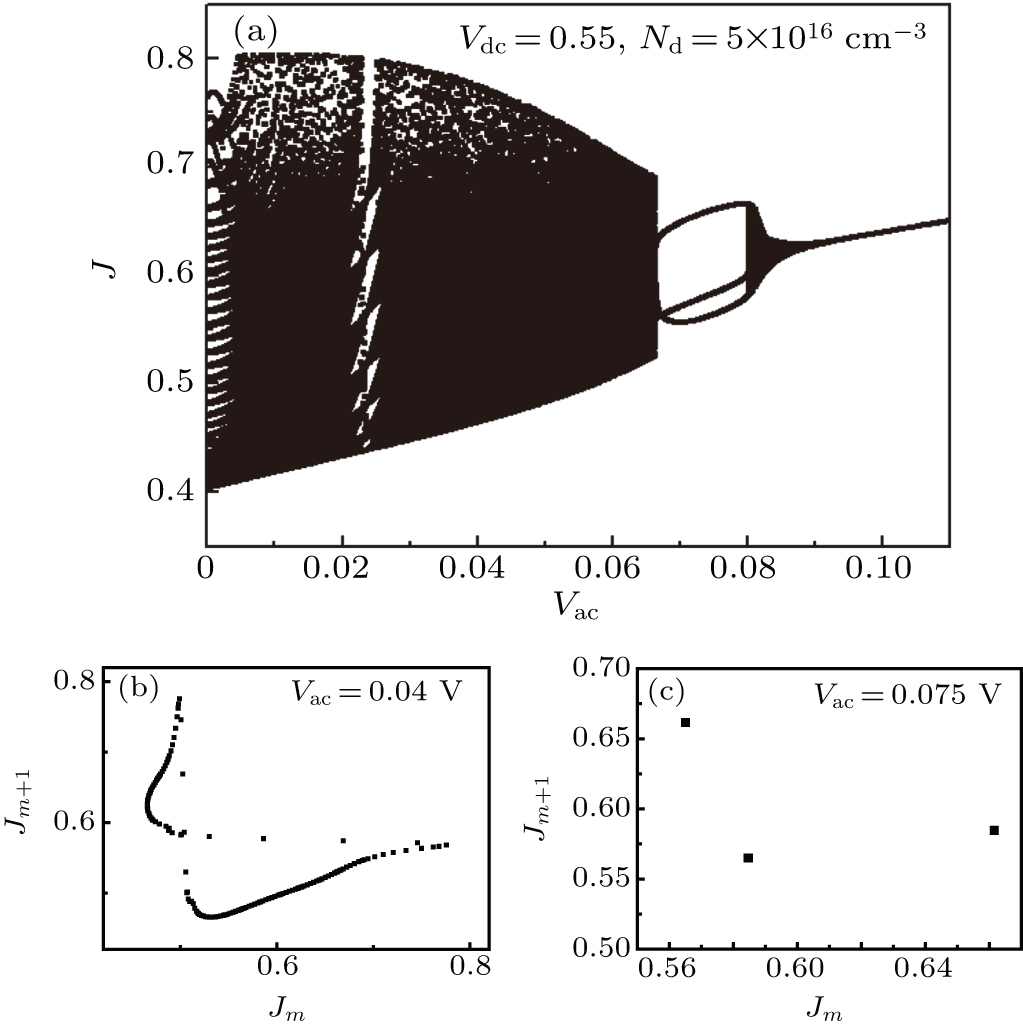† Corresponding author. E-mail:
Project supported by the National Natural Science Foundation of China (Grant No. 11604126) and China Scholarship Council (Grant No. 201808695016).
Hydrodynamic calculations of the chaotic behaviors in n+nn+ In0.53Ga0.47As devices biased in terahertz (THz) electric field have been carried out. Their different transport characteristics have been carefully investigated by tuning the n-region parameters and the applied ac radiation. The oscillatory mode is found to transit between synchronization and chaos, as verified by the first return map. The transitions result from the mixture of the dc induced oscillation and the one driven by the ac radiation. Our findings will give further and thorough understanding of electron transport in In0.53Ga0.47As terahertz oscillator, which is a promising solid-state THz source.
Devices operating in the THz frequency region have attracted a great deal of attention due to their wide applications, such as security inspection, imaging, and radar.[1–4] Compact and coherent solid-state THz sources working at room temperature are fundamental and important for such applications. Various devices have been investigated theoretically and experimentally as THz sources, from both optical and electronic aspects. As a typical optical device, the quantum cascade laser (QCL) represents an efficient coherent THz source,[5] but its low operating temperature is a major limitation. As typical electronic devices, resonant tunneling diodes (RTDs), silicon complementary metal oxide semiconductors (Si CMOS), hetero-bipolar transistors (HBTs), and high electron-mobility transistors (HEMTs) are being studied intensively as THz sources.[6–8] Besides, negative differential velocity (NDV) oscillators are good candidates as room-temperature THz sources.
Many recent efforts have been devoted to the NDV effect, as originally proposed by Krömer, to generate and amplify the current oscillation.[9] There are two NDV mechanisms. One is the Ridley–Watkins–Hilsum (RWH) mechanism. In a multi-valley semiconductor like GaAs and InGaAs,[10,11] the transfer of carriers into a higher energy state with larger effective mass and lower velocity results in the NDV effect. The other one is the negative effective mass (NEM) mechanism due to the nonparabolic band dispersion like in InN.[12] In a single nonparabolic band, when the electron transits through the inflection point, its effective mass changes sign to be negative, leading to a different NDV effect. Various materials have been explored as NDV THz oscillators.[13,14] In 2007, the first hetero-structure planar Gunn diode based on AlGaAs/GaAs was demonstrated with operating frequency above 100 GHz.[15] However, the frequency of the device, as limited by GaAs’s saturation velocity, cannot be increased efficiently to high enough. To overcome this disadvantage, In0.53Ga0.47As layer, which has a good lattice match to the InP substrate, was proposed to replace GaAs. In 2013, the first 164 GHz In0.53Ga0.47As diode was achieved.[16] To increase the frequency further, a submicron In0.53Ga0.47As diode in a planar layout was proposed. Compared to the linear optical and electronic responses in In0.53Ga0.47As, which have been extensively studied, fewer investigations are based on nonlinear transport effects. The external radiation on the device is expected to result in complicated transport of electrons and the resulting oscillations are time- and space-dependent. Thus, nonlinear transport effects are very essential and efficient for nonequilibrium optical and electronic processes. They are crucial for a thorough understanding of fundamental properties of the In0.53Ga0.47As oscillator.
In the present work, we apply a hydrodynamic model to investigate nonlinear dynamics in n+nn+ In0.53Ga0.47As diode. Although the Monte–Carlo method has been widely used in the theoretical investigations of the lattice-matched In0.53Ga0.47As for Gunn oscillators,[14,17,18] the hydrodynamic model has higher efficiency by exploiting some reasonable approximations. Using the hydrodynamic model, we have previously studied the current self-oscillation in the n+nn+ In0.53Ga0.47As diode under dc bias. Here we continue to investigate the chaotic behaviors under THz radiation by carefully tuning the parameters of dc bias, doping concentration, and intensity of radiation.
InGaAs pronounced NDV feature was reported theoretically and experimentally.[11] Figure

 | Fig. 1. (a) Fitting Vd–E curve of InGaAs at room temperature in comparison with experiment. (b) Self-current oscillations under two different dc biases. |
To get a better understanding of the oscillations in n+nn+ InGaAs THz oscillator, we next investigate the oscillatory modes of the diode under the influences of both self-sustained electric field and external THz radiation in the form of








The effect of the dc voltage on the current has also been considered and simulated. Figure
To summarize, by applying hydrodynamic equations, we have simulated the nonlinear dynamics in n+nn+ In0.53Ga0.47As diodes subjected to both dc and ac signals. The dependence of the cooperative nonlinear oscillatory mode on th edc bias, doping concentration, and ac intensity has been carefully analyzed. The transitions between periodic and chaotic patterns are revealed and originate from the mixture and competition between the intrinsic oscillation and the ac-induced one. Our findings will provide further fundamental understanding of In0.53Ga0.47As diodes, applicable as a promising solid-state source for THz applications.
| [1] | |
| [2] | |
| [3] | |
| [4] | |
| [5] | |
| [6] | |
| [7] | |
| [8] | |
| [9] | |
| [10] | |
| [11] | |
| [12] | |
| [13] | |
| [14] | |
| [15] | |
| [16] | |
| [17] | |
| [18] | |
| [19] | |
| [20] | |
| [21] | |
| [22] | |
| [23] | |
| [24] | |
| [25] | |
| [26] | |
| [27] |



